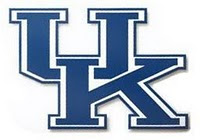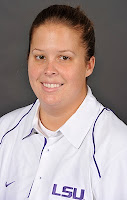
The LSU Athletic Training Department would like to share another case study which was submitted by one of our Athletic Training Students to the SEATA Student Symposium for presentation. Madeleine Scaramuzzo is a 2nd year Athletic Training Student in the LSU Athletic Training Department, having worked at University High and currently assigned to assist with the Football Program. She authored a case study on "Phantom Pain in a Collegiate Football Player". Below is the abstract including: Personal Data, Past and Current Personal Medical History, Signs and Symptoms, Differintial Diagnosis, Imaging and Lab Results, Final Diagnosis, Treatment and Outcome, and Deviation From the Expected.
AUTHORS AND AFFILIATION
Madeleine Scaramuzzo, Athletic Training Student, Louisiana State University, Baton Rouge, Louisiana Andy Barker, MS, ATC, LAT, Senior Associate Athletic Trainer, Louisiana State University, Baton Rouge, Louisiana
Personal Data
The patient is a nineteen year old Caucasian male collegiate football placekicker.
Past Personal Medical History
The patient was born without a left upper extremity. The shoulder joint, including a portion of the humerus and the musculature of the shoulder, was present at birth. The musculature of the upper arm and below, including the biceps brachii muscles, triceps brachii muscles, coracobrachialis muscle, and others were absent at birth. During the patient’s childhood the humerus experienced some growth, and therefore the patient was required to undergo multiple surgeries in which the end of the humerus was shaved down. The patient has no family history of congenital limb abnormalities or missing limbs.
Current Medical History
The patient reports neuropathic pain occurring in the absent limb from time to time. Hitting the tip of the arm can sometimes elicit these symptoms; however, the symptoms can also occur without provocation. The patient is otherwise healthy and the missing limb has no effect on his overall health.
Physical Signs and Symptoms
The patient experiences several abnormal sensations occurring in the absent limb on a monthly basis. These abnormal sensations include feelings of pain that originate in the shoulder and upper arm and seem to run down the length of the arm to the absent hand. The patient describes the pain as “a nail running down through the entire arm.” In addition to pain, the patient experiences an abnormal sensation of water running down the “entire” arm after getting out of the shower. The patient also occasionally experiences what seems to be an itching sensation in the absent hand. Other sensations described by the patient include a thumping pain located at the tip of the limb, and a constant shocking pain occurring during cold weather which can be relieved by applying pressure to the limb. Because of the lack of blood vessels and overall abnormal vasculature in the left limb the patient experiences random periods of burning and heat which resolve on their own. During these periods of burning and heat the left limb is visibly red and warm to the touch.
Differential Diagnosis
Neuropathy, spinal cord injury, Phantom Limb
Results of Diagnostic Imaging/Laboratory Tests
N/A
Final Diagnosis
Phantom arm pains
Treatment & Outcome
The patient has never sought medical treatment for the condition because the signs and symptoms have never been severe enough to warrant it. The patient does admit, however, to taking over the counter NSAIDs occasionally to relieve symptoms. Other possible treatments include narcotics, anticonvulsant medication, and antidepressants. A form of treatment that could be beneficial to this patient and other patients with phantom limb pain is mirror box therapy. The mirror box is a box with two compartments separated by a mirror. The patient places both limbs in the box on either side of the mirror and watches the mirror on the side of the intact limb. This will create the appearance of the missing limb and can help to cure phantom pains.
Deviation from the Expected
What makes this case unique is that Phantom Limb is a condition that usually occurs in an amputated limb, however this case is seen in a congenitally absent limb. With Phantom Limb the brain still believes that the amputated limb is present because the brain was equipped with the necessary neurologic anatomy of the limb at birth. Therefore, the brain continues to send information to it, resulting in pain and abnormal sensations. With phantom arm pains the abnormal sensations experienced by the patient with a congenital missing limb occur because the neurological wiring in the brain may not be consistent with the actual anatomy of the limb, causing inappropriate sensations.
 On March 11, 2011, a devastating 8.9 scale earthquake hit the country of Japan, causing yet another deadly natural disaster, a 10 meter high tsunami that destroyed the lives and homes of many residents of Japan and the Pacific Coast.
On March 11, 2011, a devastating 8.9 scale earthquake hit the country of Japan, causing yet another deadly natural disaster, a 10 meter high tsunami that destroyed the lives and homes of many residents of Japan and the Pacific Coast.  Noritoshi Shirakawa, ATC, former LSU Athletic Training Student (2007-2010) and current Certified Graduate Assistant Athletic Trainer at the University of Illinois is a native of Japan. Nori was an excellent student in the LSU Athletic Training Education Program, and was the award winner of the prestigious Academic Achievement Award two years in a row, as well as the NATA Research and Education Foundation Master's Scholarship in 2010. He was assigned to Football in 2007 and was part of the 2007 National Championship team. Nori was also part of very successful Track and Field and Softball programs. In the summers of 2008 and 2009, Nori also fulfilled interests in completing an NFL Internship with the Houston Texans and an MLB Intership with the Texas Rangers. Working with his native country, Nori also provided medical services to the Nippon Tornados, an independent semi-professional basketball team.
Noritoshi Shirakawa, ATC, former LSU Athletic Training Student (2007-2010) and current Certified Graduate Assistant Athletic Trainer at the University of Illinois is a native of Japan. Nori was an excellent student in the LSU Athletic Training Education Program, and was the award winner of the prestigious Academic Achievement Award two years in a row, as well as the NATA Research and Education Foundation Master's Scholarship in 2010. He was assigned to Football in 2007 and was part of the 2007 National Championship team. Nori was also part of very successful Track and Field and Softball programs. In the summers of 2008 and 2009, Nori also fulfilled interests in completing an NFL Internship with the Houston Texans and an MLB Intership with the Texas Rangers. Working with his native country, Nori also provided medical services to the Nippon Tornados, an independent semi-professional basketball team.  Minekazu (Kaz) Isobe, ATC, is also a former LSU Athletic Training Student (2005-2008) and native of Japan. Kaz was an outstanding Athletic Training Student at LSU, receiving the Academic Achievement Award in 2006-2007. He also participated in an NFL Internship with the Houston Texans in 2009. Kaz currently resides in Hiroshima, Japan, which is about 650 miles away from the devastation. He has been working as an Assistant Athletic Trainer with the Sanfrecce Hiroshima Japanese Professional Soccer Team in the J. League Division I. To help out LSU Alumni and those affected by the disaster in Japan and the Pacific Coast, please make a donation to the American Red Cross. Donations can be made in the name of the disaster, and can be made either online or by mail. We ask that you please take the time to support the LSU Alumni in this difficult time. To make a donation, visit the American Red Cross website.
Minekazu (Kaz) Isobe, ATC, is also a former LSU Athletic Training Student (2005-2008) and native of Japan. Kaz was an outstanding Athletic Training Student at LSU, receiving the Academic Achievement Award in 2006-2007. He also participated in an NFL Internship with the Houston Texans in 2009. Kaz currently resides in Hiroshima, Japan, which is about 650 miles away from the devastation. He has been working as an Assistant Athletic Trainer with the Sanfrecce Hiroshima Japanese Professional Soccer Team in the J. League Division I. To help out LSU Alumni and those affected by the disaster in Japan and the Pacific Coast, please make a donation to the American Red Cross. Donations can be made in the name of the disaster, and can be made either online or by mail. We ask that you please take the time to support the LSU Alumni in this difficult time. To make a donation, visit the American Red Cross website. 


























